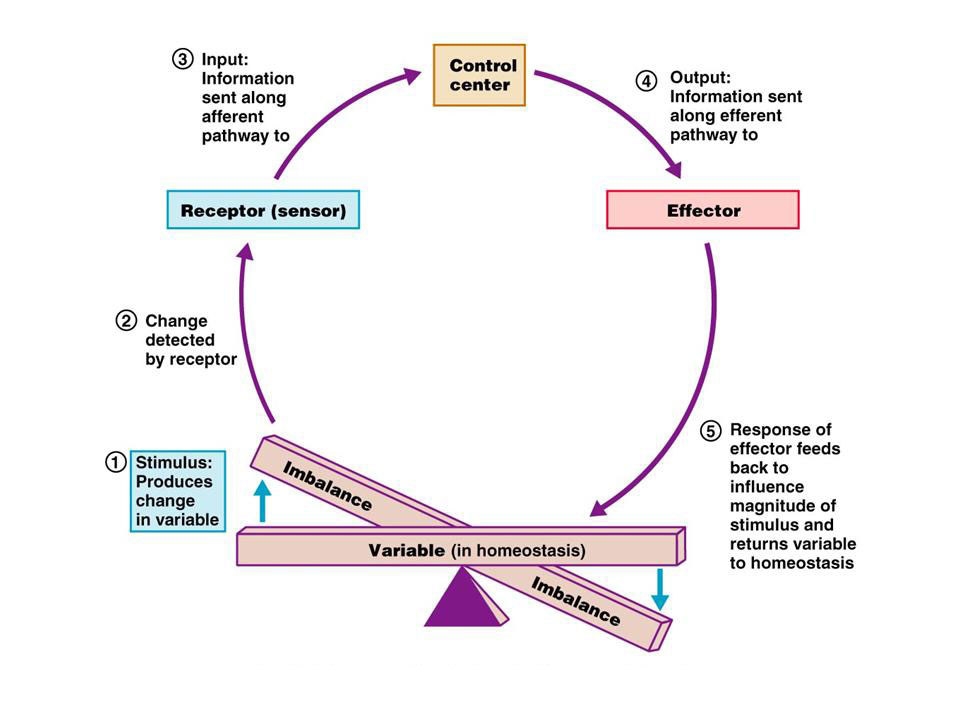Homeostasis
The biological definition of homeostasis is “the tendency of an organism or cell to regulate its internal environment and maintain equilibrium, usually by a system of feedback controls, so as to stabilize health and functioning”. Generally, the body is in homeostasis when its needs are met and its functioning properly.
Every organ in the body contributes to homeostasis. A complex set of chemical, thermal, and neural factors interact in complex ways, both helping and hindering the body while it works to maintain homeostasis.
Homeostatic control
To maintain homeostasis, communication within the body is essential. The image below is an example of how a homeostatic control system works. Here is a brief explanation:
- Stimulus– produces a change to a variable (the factor being regulated).
- Receptor– detects the change. The receptor monitors the environment and responds to change (stimuli).
- Input– information travels along the (afferent) pathway to the control center. The control center determines the appropriate response and course of action.
- Output– information sent from the control center travels down the (efferent) pathway to the effector.
- Response– a response from the effector balances out the original stimulus to maintain homeostasis.
Interactions among the elements of a homeostatic control system maintain stable internal conditions by using positive and negative feedback mechanisms.
Think of it as an extremely complex balancing act. Here’s a few more definitions you may want to know.
Afferent pathways– carry nerve impulses into the central nervous system. For instance, if you felt scorching heat on your hand, the message would travel through afferent pathways to your central nervous system.
Efferent pathways– carry nerve impulses away from the central nervous system to effectors (muscles, glands).
The feeling of heat would travel through an afferent pathway to the central nervous system. It would then interact with the effector and travel down the efferent pathway, eventually making the person remove their hand from the scorching heat.
Negative feedback mechanisms
Almost all homeostatic control mechanisms are negative feedback mechanisms. These mechanisms change the variable back to its original state or “ideal value”.
A good example of a negative feedback mechanism is a home thermostat (heating system). The thermostat contains the receptor (thermometer) and control center. If the heating system is set at 70 degrees Fahrenheit, the heat (effector) is turned on if the temperature drops below 70 degrees Fahrenheit. After the heater heats the house to 70 degrees Fahrenheit, it shuts off effectively maintaining the ideal temperature.
The control of blood sugar (glucose) by insulin is another good example of a negative feedback mechanism. When blood sugar rises, receptors in the body sense a change . In turn, the control center (pancreas) secretes insulin into the blood effectively lowering blood sugar levels. Once blood sugar levels reach homeostasis, the pancreas stops releasing insulin.
These are just two examples of negative feedback mechanisms within our body, there are 100’s, can you think of a few more?
Positive feedback mechanisms
A positive feedback mechanism is the exact opposite of a negative feedback mechanism. With negative feedback, the output reduces the original effect of the stimulus. In a positive feedback system, the output enhances the original stimulus. A good example of a positive feedback system is child birth. During labor, a hormone called oxytocin is released that intensifies and speeds up contractions. The increase in contractions causes more oxytocin to be released and the cycle goes on until the baby is born. The birth ends the release of oxytocin and ends the positive feedback mechanism.
Another good example of a positive feedback mechanism is blood clotting. Once a vessel is damaged, platelets start to cling to the injured site and release chemicals that attract more platelets. The platelets continue to pile up and release chemicals until a clot is formed.
Just remember that positive feedback mechanisms enhance the original stimulus and negative feedback mechanisms inhibit it.






























0 Comments: